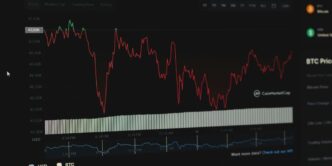The cryptocurrency market is experiencing significant turbulence as Bitcoin’s price dipped to around $94,000 amid rising economic uncertainty and inflation concerns. This decline has sparked contrasting reactions between institutional investors and retail traders, highlighting a divide in market sentiment.
Key Takeaways
- Bitcoin’s price fell to approximately $94,091, marking a 3% decrease in 24 hours.
- Institutional investors are buying aggressively, while retail traders are panic selling.
- The U.S. Consumer Price Index (CPI) data exceeded expectations, raising inflation worries.
- The Federal Reserve’s cautious stance on interest rates adds to market uncertainty.
Bitcoin’s Price Volatility
Bitcoin’s recent price action reflects a broader trend of volatility in the cryptocurrency market. As of February 12, 2025, Bitcoin was trading at $94,672, down from previous highs. The Relative Strength Index (RSI) has dipped below 50, indicating weakening bullish momentum. Analysts are closely monitoring the 200-day moving average, which currently stands at $92,000, as a critical support level.
Diverging Sentiments: Retail vs. Institutional
The current market dynamics reveal a stark contrast between retail and institutional investors. Retail traders are exhibiting signs of panic, reacting to price fluctuations with sell-offs. In contrast, institutional investors are seizing the opportunity to accumulate Bitcoin, viewing the current dip as a potential buying signal. This divergence in sentiment could play a crucial role in determining Bitcoin’s future price trajectory.
Economic Factors Influencing Bitcoin
Several economic factors are contributing to the current market uncertainty:
- Inflation Concerns: The latest CPI data showed a 0.5% increase in January, surpassing expectations. This marks the highest inflation reading since June 2024, raising concerns about prolonged high rates.
- Federal Reserve’s Stance: Federal Reserve Chair Jerome Powell’s comments on a cautious approach to interest rate cuts have led to speculation about delayed monetary easing. The market’s expectations for rate cuts have significantly decreased, with traders now favoring later dates for potential policy changes.
- Tariffs and Trade Policies: Recent tariffs imposed by the Trump administration on steel and aluminum imports have added to market uncertainty, affecting both traditional and digital assets.
The Path Ahead for Bitcoin
As Bitcoin navigates this turbulent landscape, analysts are divided on its next move. A breakout above $98,500 could signal a rally towards new highs, while a drop below $94,000 may lead to further declines towards the $90,000 mark. The market is at a critical juncture, and traders are advised to remain vigilant as they assess potential price movements.
In conclusion, Bitcoin’s recent dip to $94,000 underscores the impact of economic uncertainty on the cryptocurrency market. With institutional investors showing confidence amidst retail panic, the future of Bitcoin remains uncertain but intriguing as it faces pivotal economic challenges.














